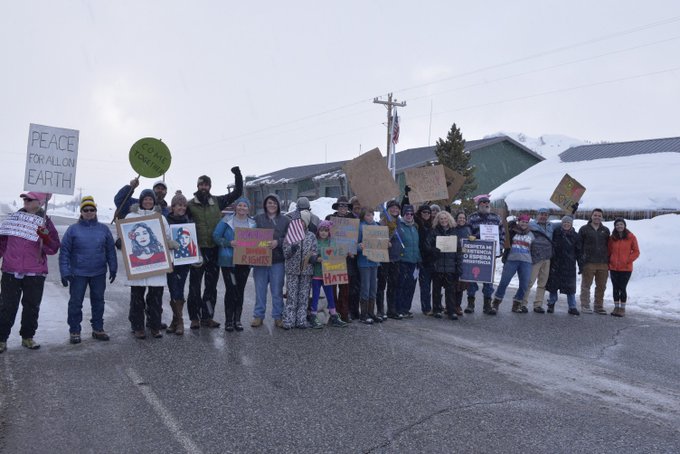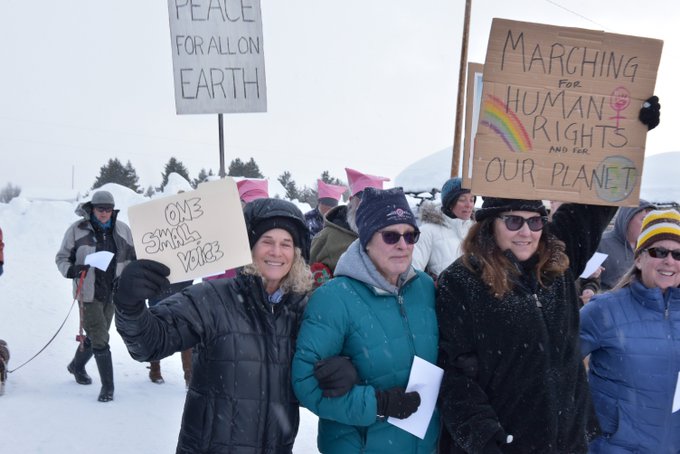The first protest of The Resistance was yuuuge
by digby
I know it was organized by women and was largely about women’s rights so it really only counts for half, but still. Via Vox:
Crowd estimates from Women’s Marches on Saturday are still trickling in, but political scientists say they think we may have just witnessed the largest day of demonstrations in American history.
According to data collected by Erica Chenoweth at the University of Denver and Jeremy Pressman at the University of Connecticut, marches held in more than 500 US cities were attended by at least 3.3 million people.
Sarah Frostenon
“Even using a conservative estimate, it was the single largest day for a demonstration in the US,” Chenoweth, an expert on political protests and civil resistance, told us.
Almost every state in America hosted a Women’s March, as you can see in the map above. The events ranged from tiny gatherings in small town squares to throngs of more than 500,000 people clogging streets in cities like Washington, DC, and Los Angeles. (If you see that crowd attendance information is missing from your city, please contact the researchers here.)
Pressman said he started to track crowd numbers from organizers, local media outlets, and citizens who emailed or tweeted with links and reports early Saturday morning.
Chenoweth offered to help him, after being struck by how many people she saw at the march in her hometown of Denver.
“It was much bigger than I expected, and by the time I got home I was really curious if that was happening nationwide or not,” said Chenoweth.
The researchers say much of their data is still incomplete and will change in the coming days as more estimates become available. Roughly 200 marches held across the US still haven’t released any attendance numbers yet.
But Chenoweth said she was stunned by how many communities across America held sister marches to the main event in Washington, DC. She and Pressman received data from places like Stanley, Idaho (population of 63), where nearly half the town — 30 people — came out to protest, including resident celebrity Carole King.
The turnout at events outside the US was significant, too. Chenoweth and Pressman have recorded over 100 international Women’s Marches with an estimated attendance of more than 260,000.
Chenoweth cautioned me that while 3.7 million Americans protesting on Saturday may be the largest turnout in US history in absolute terms, she wasn’t sure if it was the largest protest proportionally speaking. For instance, she said, it’s possible that protests in cities around the US against the Iraq War in 2003 may have drawn as many people or more relative to the population at that time.
As she and Pressman continue to collect data, she hopes that civic organizers will be more involved with gathering crowd data in real time to help researchers who study social movements.
“For people who organize these kinds of activity, there is something that can be learned in terms of techniques of using [satellite images or aerial photos] to estimate crowd density,” said Chenoweth. “It might be a good time to think about how we democratize that knowledge.”
I think democratizing knowledge is going to be extremely important going forward. In a world with “alternate facts” coming from the government we are going to be unable to function unless we develop some methods of keeping track of reality.
I don’t know if it’s true that the marches were larger than any in history. But they were big, very big and dispersed all over this country. And what really makes it special wasn’t the big crowds in DC, NY, Chicago and LA. It as that people in small towns in red states came out in defiance of their community’s majority and made themselves known. That’s never easy. It was difficult during the campaign for a lot of reasons. To do that takes guts and the women and their allies who did it this past week-end have my respect.
That’s the heart of The Resistance and I was proud to stand with them.
.



